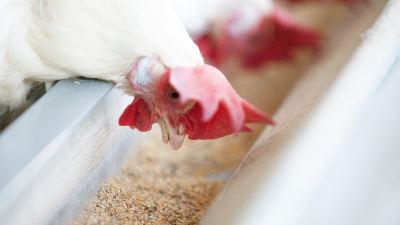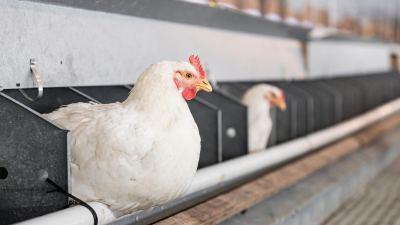Dr. Peter Ferket: Count your chickens before they hatch

The poultry industry is seeing a 50-gram increase in weight for a 42-day-old bird every year. By using perinatal nutrition to guide epigenetic responses, we can improve the quality, immunity and adaptability of these rapidly growing birds before they even hatch.
Tom: Dr. Peter Ferket is a professor of nutrition and biotechnology in the department of poultry science at North Carolina State University and the author of more than 500 publications and seven patents. He is known for his work on perinatal nutrition and development and other nutritional factors that affect the yield and quality of meat, nutritional value of food, industry coproducts and nutrient management. He’s here to talk to us about improving the quality of chickens and turkeys before they hatch. Thank you for joining us.
Peter: Thank you, Tom.
Tom: First, let’s take a look in the rearview mirror. How far have we come in poultry?
Peter: When you consider what the poultry industry has done over the past 60 years or so, it’s been nothing short of amazing. Sixty years ago, to get to our consumer-size market, it took 12 weeks. It was just a small, scrawny, little bird. But that same 4-pound broiler chicken today can do this in almost 30 days.
When you think about the genetic potential for growth for these amazing animals, we are seeing about a 1 percent improvement in live performance every single year. That’s a 50-gram increase in weight for a 42-day-old bird or market bird every year.
This is quite an amazing challenge as well. With the genetic potential of these birds, it’s actually more difficult to understand how to feed and to meet the nutritional requirements for that rapidly growing animal.
Tom: Do you attribute this to genetic science?
Peter: Yes. We have learned a lot about not only selecting and understanding variability and selecting animals for certain growth, but now, because of the genetic science and being able to understand the gene and blueprints that are associated with it, being able to measure certain traits and select for those, this is still a natural selection kind of science.
But because we have the tools, we can rapidly meet those needs and get traits that are desirable for not only the welfare of the animal, but their growth performance, meat quality, et cetera.
Tom: What’s the difference between genetics and epigenetics?
Peter: Epigenetics is the expression of the genes. So, genes are like the blueprint. Epigenetics is like taking a part of that gene or that blueprint and actually creating something, like going to work and building a house. You start with a blueprint, but the “carpenters” go to work and take that blueprint and begin to produce a product.
Epigenetics takes a certain part of that gene and now says, “Okay. I need to express that part and turn it into proteins, turn it into something that can now create what you’re really meaning to create.” It’s the phenotypic type of response. What we call “phenotype” is creating what the bird looks like, behaves like and grows like.
Tom: Does the genetic technology CRISPR come into play?
Peter: That is a technique of trying to now modify that gene and how that expresses. So, we’re still starting to learn how to do that with animals. We’re using it with lots of plants now. This is a very new technique that allows us to now modify the gene. So, you’re not actually doing a gene modification. The CRISPR just says, “Let’s take out a piece that’s not functioning well and make it work better.”
Tom: Interesting. What kind of impact can nutrition have especially in the early life of a bird?
Peter: You’ve heard the saying, “You are what your mama ate.” And very often, when we are young — it doesn’t matter if it’s a human, a chicken or even a plant as it’s just beginning to grow — we need to sense what the environment is like and then adapt by epigenetic responses to the environment so that we’re adapted to the life we’re going to be in.
With early nutrition, we can do certain things like provide nutrients at critical periods of time so the genes are expressed in a way that we’d like — more adapted to the environment that that animal is going to grow in.
For example, if we want — I’m talking physiological kinds of response — if we want an animal to be more adapted to hot weather, you expose it to hot weather for a short period of time when it’s young. If we want to now create something where an animal is more efficient in a specific nutrient, we can actually reduce the nutrient, make that animal work a little bit harder for that, and it up-regulates parts of its genome or its gene expression and machinery so that it’s more efficient to get those nutrients, and that very often lasts for the rest of their life.
So, with early nutrition, we have an opportunity to manipulate the nutrition, the physiology and those kinds of things in a way that they are better adapted for life later.
Tom: I want to get to something that I mentioned in the introduction. Can we begin getting that bird off to a good start even before it hatches?
Peter: Yes. That’s the amazing thing that we’ve been working on for the past almost 10 years. What we first found out is that the chicken’s first meal is not its first mouthful of food when it hatched. Like all of us when we’re embryos, we’re surrounded by amniotic fluid. It’s that fluid that surrounds that embryo. The chick, as well as humans and others, swallow that amniotic food just before they’re either hatched or born. That amniotic fluid contains nutrients that the mother or the dam provides. But, sometimes it’s deficient in certain things or doesn’t have the certain trace minerals or nutrients required to turn on the “machinery” so that the animal develops well. So, we now supplement that first meal — the amniotic fluid. When that chick consumes it, it gets a better complement of the nutrients that it needs to grow.
Tom: What is the outcome? What is the difference that you see?
Peter: We use nutrigenomics to test metabolism, and we found that if we want an animal to have better immunity, we know there are certain kinds of components that we can put in the diet — or in that amniotic in ovo feed, as we call it — that would up-regulate some aspects and balance nutrition or immunity. We got development to be better.
We can add in certain nutrients that will help the growth of those enterocytes — the gut cells. Or if we want better breast muscle development, or better behavior in some ways, or have animals be more alert, there are certain critical nutrients that we know that play an important role in the metabolism that influences those traits.
Tom: What is nutritional imprinting, and what kind of an impact does that have on the bird?
Peter: Nutritional imprinting is much like the epigenetics story. Imprinting is an adaptive conditioning using nutrition to allow it to adapt to what we would like. So, for example, I would like to imprint an animal that’s more efficient in phosphorus utilization. That’s a good thing because dietary phosphorus is expensive. If you can improve phosphorus utilization, you have less going into the environment.
Imprinting would be for a short period of time when they’re very young. You feed a diet that is very low in phosphorus, and that allows the animal’s system to say, “I need more phosphorus. I’m going to up-regulate my systems to be more efficient for phosphorus utilization.” That imprints them for the rest of their life.
Imprinting is something that’s biologically very conserved in nature — like imprinting, let’s say, a child on a mother. That occurs very young. Same thing whether it’s imprinting to some sort of an environmental temperature. We can do the same thing with nutrition. We can imprint animals for certain nutritional things that we would like to make things more efficient later in life.
Tom: How do these genetic and nutritional technologies affect the average consumer’s dinner table?
Peter: I think people are, first of all, concerned that we’re manipulating genes. No, these are just natural genes that you and I all have.
But now we’re starting to understand what turns on a gene for the good and what turns on a gene for the bad. By doing that, we can feed an animal in a way that they will be better adapted for the life that they’re going to be in. That’s good because you can now make sure that the animal has better welfare, that the food, for instance, would be healthier and that the animal is more resistant to diseases.
There are a number of things that, in the end, turn out being very good for the consumer. A big active part of my work is trying to find techniques and ways to enhance the animal’s resistance to enteropathogens so that we don’t have to put antibiotics in feed. We can use natural compounds in the diet together with the animal’s own system to be able to maintain health without having to rely on things like we have in the past, like antibiotics and drugs.
Tom: It sounds like really interesting work. What do you enjoy most about it?
Peter: You know, the most enjoyable thing is the research. Yes, those are exciting things. But the most exciting thing about my work is that I’m a teacher. I’m a professor. It’s about instilling dreams into our students’ minds, the creativity, what’s possible, taking something that we know in science and letting them loose to create an opportunity. I think that’s the thing that just makes me go to work every day with tremendous joy. I can see my students and those around me use some of the information that we learn in science to create and do better things. I always tell my students, “Take this and go save the world.”
Tom: Dr. Peter Ferket, professor of nutrition and biotechnology in the department of poultry science at North Carolina State University. Thank you so much for joining us.
Peter: You’re welcome, Tom.
Dr. Peter Ferket spoke at ONE: The Alltech Ideas Conference (ONE17). To hear more talks from the conference, sign up for the Alltech Idea Lab.















